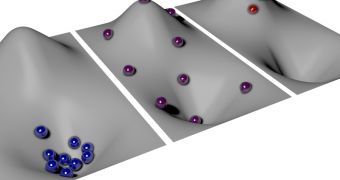There aren't that many things set in stone in science, but Absolute Zero, the lowest possible temperature at which atomic movement stops altogether was one of them. But you can thank quantum physics, the ultimate troll of the physics world, for ruining this as well.
Scientists have been able to go below zero Kelvin, -460°F or -273°C, something that was previously thought impossible. It is still impossible, you can't get any cooler than zero Kelvin, all movement has already stopped.
But that hasn't stopped scientists from adding a negative side to the Kelvin scale, making it possible to get negative temperatures.
Negative temperatures on the Kelvin scale aren't colder than positive ones, in fact, they're hotter than any possible positive temperature.
To try to understand negative temperatures, think of the Kelvin scale not as a straight line but as a loop.
Temperatures approach zero Kelvin and then go below into negative territory. At the same time, infinite Kelvin is not the end of the scale, beyond it are very high negative temperature.
At the atom level, temperature has a direct link to the energy level distribution of atoms. The cooler a gas is, the more likely it is that atoms will occupy lower energy states. As it heats up, more atoms occupy higher energy states, but most still tend to stay at the lower ones.
This is known as the Boltzmann distribution. Eventually, at infinite temperature, all energy states are equally probable, meaning atoms will occupy any of them.
As we push into the negative temperature range, things get strange, here atoms tend to occupy the higher energy states rather than the lower ones, the exact opposite of positive temperatures.
Negative temperatures are not possible in all systems as they would require infinite energy. However, some systems have an upper limit to the amount of energy they can absorb and get hotter.
Once the limit is reached, energy can still be pushed into the system, but it won't get any hotter, rather it will move over to the negative temperature range.
Temperature is directly linked to the movement of atoms, the less movement the cooler a system is. But temperature is also linked to the amount of energy in a system. Normally, increasing the total energy increases the movement, i.e. kinetic energy.
But if you manage to increase the amount of energy without increasing kinetic energy, you can push a system into negative temperatures. Researchers were able to devise an experiment that created such a system.
They cooled a gas of a few hundred thousand atoms to a few nanokelvin, a billionth of a Kelvin, very close to absolute zero.
At this temperature, virtually all movement stops. The scientists then immobilized the atoms using a laser lattice limiting their movement, therefore creating an upper bound to the kinetic energy. The atoms could still change position via quantum tunneling.
Incidentally, this is yet another application of quantum optics, which won the Nobel prize in physics for the two people awarded this year.
The potential energy and interaction were also limited in the experiment. This way, the scientists were able to push the system to negative temperatures of a few nanokelvin. What's more, that state was actually stable.
A system at a very low temperature is stable, isolated from outside factors, the balls are all in the valley in the image to the left.
Atoms (or balls) at higher energy levels, the top of the hill, will tend to go down to the valley, therefore converting their potential energy into kinetic energy.
"If the balls are at a negative temperature, however, their kinetic energy will already be so large that it cannot increase further," Simon Braun a PhD student part of the research explained. "The balls thus cannot roll down, and they stay on top of the hill. The energy limit therefore renders the system stable!"
The discovery has great practical potential. Using negative temperatures, thermal engines operating at above 100 percent efficiency are possible.
This doesn't violate the law of energy conservation, rather, the engine could absorb energy from the hotter medium but also from the colder medium.
Negative temperatures are also of interest to cosmologists and matter at these temperatures behaves in similar ways to how dark energy is believed to act.
The universe, in the absence of some mysterious phenomenon, i.e. dark energy, should collapse onto itself due to gravity. This isn't happening, quite the contrary, the universe's expansion is accelerating.
The same has been observed in the gas at negative temperatures. At regular temperatures, atoms would repel each other, but at negative ones they attract, creating negative pressure. This should mean that the gas should collapse onto itself; yet this doesn't happen, due to the negative temperature.
This is how the scientists got the gas to drop to negative temperatures. They made the atoms attract each other using a magnetic field. At positive temperatures this would mean the collapse of the sytem, but the atoms were locked into place by the lasers. Unable to move, instead of moving towards each other, the temperature dropped to the negative teritorry.

 14 DAY TRIAL //
14 DAY TRIAL // 
